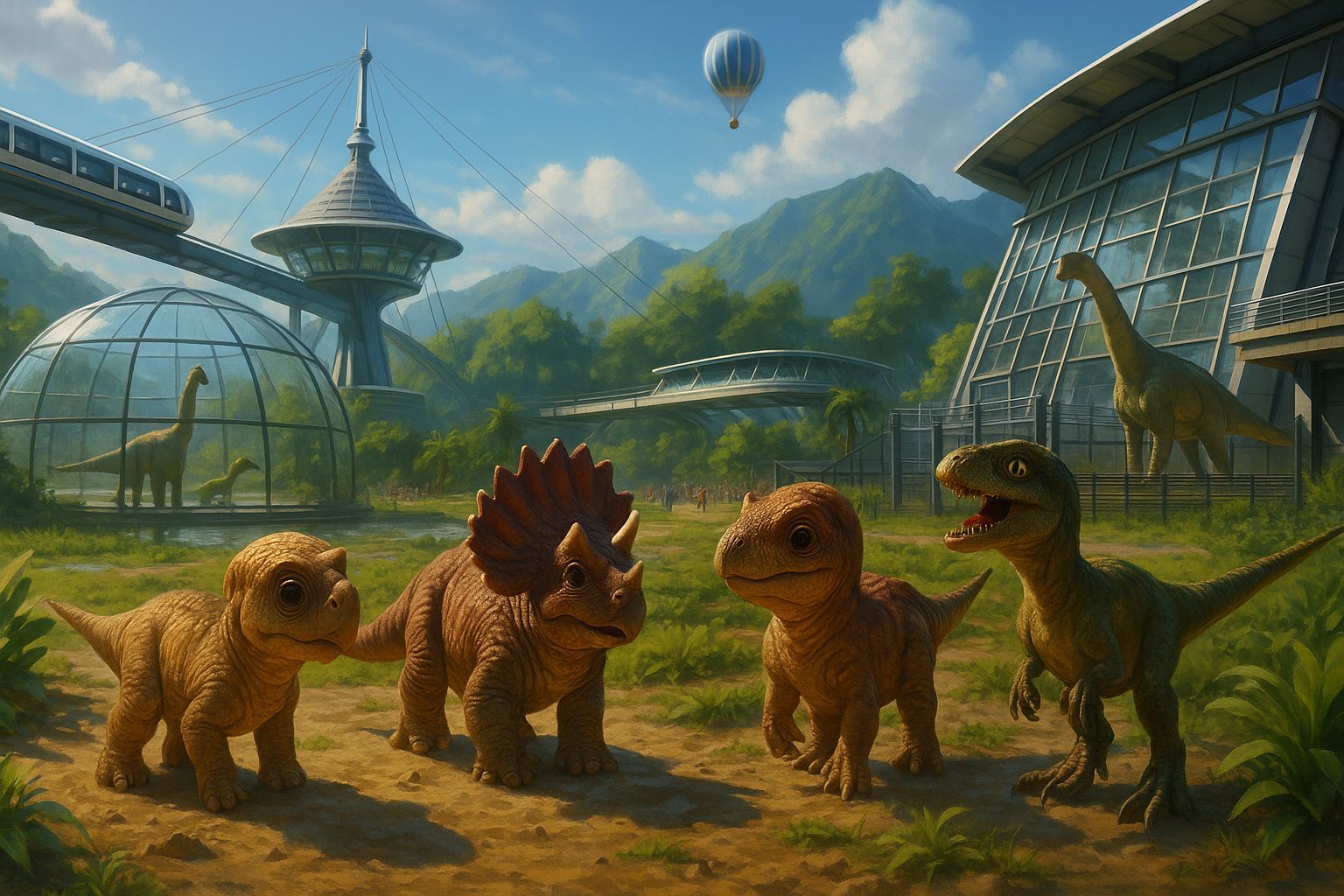Jurassic World Evolution 3 Review: The Park Evolves

The Jurassic World Evolution series continues its legacy with Jurassic World Evolution 3, a sequel that blends simulation depth, cinematic storytelling, and the pure thrill of running your own park filled with prehistoric animals. Released on October 21, 2025, this latest entry cements Frontier Developments as a master of the management genre, following successes like Planet Zoo and Planet Coaster.
In this new chapter, the studio balances creativity and control — inviting players to build, breed, and explore like never before.
The Evolution Continues: What’s New in the October Sequel
Baby Deinonychus and Family Mechanics
The most charming and talked-about addition is the introduction of baby dinos. Players can now breed dinosaurs naturally, hatch eggs, and nurture juveniles that grow into adults with unique traits. From fluffy Deinonychus hatchlings to tiny Stegosaurus offspring, each species exhibits its own personality.
Unlike the previous games, which focused mainly on adult creatures, Jurassic World Evolution 3 introduces a full life-cycle system. The dinosaur integration network tracks social bonds and bloodlines, meaning baby dinosaurs inherit both genetic modifications and temperamental quirks from their parents.
These elements add depth and replayability — every generation can shape your park’s ecosystem in subtle, fascinating ways.
Jeff Goldblum Returns as Dr. Ian Malcolm
The return of Jeff Goldblum in the campaign mode is pure nostalgia for fans of the original Jurassic Park. His witty remarks punctuate the narrative as he guides players through complex ethical and management dilemmas. Alongside familiar characters, Malcolm questions whether humanity should once again meddle with nature.
His voice performance gives emotional weight to what could otherwise be just another management sim. As one reviewer put it, “It wouldn’t be Jurassic World without Jeff Goldblum warning us that life, uh, finds a way.”
Expansive Gameplay and New Creative Tools
The gameplay loop remains familiar yet deeper. Players build attractions, manage guest satisfaction, and balance scientific research with safety — but now with new creative tools and modular construction options.
Frontier Developments took cues from Planet Zoo, introducing terrain sculpting, freeform pathing, and structural editing. You can craft glass tunnels through lagoons or perch viewing decks on volcanic cliffs.
The island generator lets you randomize terrain, climates, and biomes — from arid deserts to lush Hawaii-inspired archipelagos. These new locations bring visual diversity and new management challenges, like tropical storms or volcanic activity that disrupts power and enclosures.
Campaign Mode and Chaos Theory Mode
The campaign mode offers a globe-spanning story that explores the moral tension between control and chaos. Each mission introduces new mechanics, from breeding programs to disaster recovery.
Meanwhile, the fan-favorite Chaos Theory mode returns — a feature that lets you rewrite iconic moments from the movies. Imagine managing Isla Nublar before the fences failed, or trying to contain escaped pterosaurs during a storm. This mode celebrates the unpredictable fun that defined the earlier films.
Building Your Own Jurassic World
In sandbox mode, creativity reigns supreme. You can build your own Jurassic World, complete with aviaries, underwater domes, and aerial tours. The new balloon tour feature lets guests view dinosaurs from above, gliding over herds of Triceratops or the soaring wings of Pterosaurs.
Community integration through the Frontier Workshop returns, allowing players to share and download parks globally. Whether you’re a micro-manager perfecting exhibit layouts or a dreamer designing cinematic landscapes, JWE3’s sandbox offers limitless potential.
What DLC or In-Game Content Is Available at Launch for Jurassic World Evolution 3?
At launch, Jurassic World Evolution 3 arrives with a robust base game and a generous lineup of in-game content and DLC options designed to expand your park from day one. Frontier Developments confirmed both Standard and Deluxe Editions at release, with additional content packs available through the first post-launch roadmap.
Deluxe Edition Add-Ons
The Deluxe Edition includes five exclusive prehistoric animals unavailable in the standard version:
- Protoceratops
- Guanlong
- Thanatosdrakon
- Concavenator
- Einiosaurus
It also features three unique building skins, extra lagoon decorations, and custom signage for park personalization — letting players give their own Jurassic World a signature visual identity.
Early Access Bonuses and Skins
Players who pre-ordered received the Founder’s Pack, featuring alternate skins for the Deinonychus and Tyrannosaurus rex, inspired by the original Jurassic Park film. The pack also grants a themed visitor balloon for the balloon tour attraction, perfect for those seeking nostalgic park aesthetics.
Day-One Sandbox Expansions
The sandbox mode ships with multiple new locations from across the globe, including tropical Hawaii, the snowy peaks of Patagonia, and the deserts of northern Africa. Each map integrates seamlessly with the island generator, allowing limitless variations in terrain, flora, and weather conditions.
Players can experiment with:
- Dynamic weather systems like volcanic ash and tropical cyclones
- Hybrid dinosaur DNA combinations
- Customizable aviaries for pterosaurs
- Underwater dome viewing galleries
These features tie directly into the game’s campaign mode and chaos theory mode, ensuring that DLC creatures and decorations carry over between story missions and sandbox parks.
Frontier’s Post-Launch Roadmap
According to Frontier’s early statement, the first paid expansion — tentatively titled “Jurassic Frontier Pack” — will introduce aquatic reptiles, new dig sites, and a bonus narrative scenario featuring returning characters from the Jurassic World Evolution series. The studio also confirmed that regular free updates will add new creative tools, challenge scenarios, and optimization patches to improve gameplay performance on PC and consoles.
Why It Matters
Unlike some previous games that launched light on content, Jurassic World Evolution 3 offers a complete experience from day one. The availability of diverse DLCs and unlockable items gives players more freedom to shape their own park style — whether they prefer realistic paleontology or cinematic spectacle.
The emphasis on continued support also ensures the latest entry remains dynamic and replayable for years, reinforcing Frontier Developments’ reputation as one of the best simulation creators in the industry.
Technical Upgrades and Realism
Frontier Developments has polished the game’s simulation engine, improving AI, rendering, and pathfinding. Dinosaurs interact more realistically with each other and their environments. The Deinonychus, for instance, now hunts in coordinated packs, while gentle giants like Brachiosaurus react to changing weather conditions.
Lighting, sound, and particle effects create cinematic immersion. Dynamic day-night cycles and weather patterns add tension — torrential rain can flood enclosures or cut off access roads. These small touches make your own park feel alive.
Familiar Roots, Refined Systems
While Jurassic World Evolution 3 introduces exciting features, it also respects its previous games’ foundations. The management loop — balancing guest comfort, revenue, and security — remains addictive. Yet, now there’s room for emotional investment: watching baby dinos grow, families interact, and ecosystems stabilize or collapse.
The Frontier Developments design philosophy shows through: empower the player but respect the unpredictability of nature. This balance keeps the game engaging even after dozens of hours.
Weak Spots in the Latest Entry
Despite its many improvements, the latest entry isn’t flawless. Some critics argue that by focusing on creativity, JWE3 sacrifices some of the chaos that defined earlier titles. Disasters are less catastrophic, and dinosaur breakouts less frequent.
Others point out that the AI pathing still struggles in dense parks, and the performance dips slightly on large sandbox maps. A few players also miss the sense of discovery from the first game — since much of the dinosaur roster is already familiar.
Nonetheless, these are minor setbacks in what remains a remarkably polished experience.
Why the Sequel Still Thrives
As a sequel, JWE3 excels at learning from the past while moving forward. It integrates lessons from Planet Zoo’s user-friendly design, introduces family systems that make prehistoric life feel more authentic, and celebrates the cinematic DNA of Jurassic Park.
This fusion of nostalgia, science, and creativity makes it the best expression yet of Frontier Developments’ vision. The inclusion of pterosaurs, advanced genetics, and immersive sound design delivers a more complete vision of what running a dinosaur park could be.
What Are the System Requirements for Jurassic World Evolution 3 on PC?
Before building your own Jurassic World, make sure your PC can handle the prehistoric chaos. Frontier Developments optimized the latest entry for mid-range systems, though high-end hardware enhances performance during large sandbox builds and heavy weather effects.
Minimum Requirements:
- OS: Windows 10 64-bit
- Processor: Intel Core i5-6600 / AMD Ryzen 5 1400
- Memory: 8 GB RAM
- Graphics: NVIDIA GeForce GTX 1060 (6 GB) / AMD Radeon RX 580 (8 GB)
- Storage: 25 GB available space
Recommended Requirements:
- OS: Windows 11 64-bit
- Processor: Intel Core i7-8700 / AMD Ryzen 5 3600
- Memory: 16 GB RAM
- Graphics: NVIDIA RTX 3060 / AMD Radeon RX 6700 XT
- Storage: SSD with 25 GB free space
For smoother gameplay, disable motion blur, reduce shadow quality, and limit the number of prehistoric animals in large habitats if you’re on lower-end systems. Players using laptops or integrated GPUs can also enable “Performance Mode” introduced by Frontier for this sequel.
What Are the Early Player and Critic Reviews for Jurassic World Evolution 3?
The first wave of early reviews for Jurassic World Evolution 3 has been overwhelmingly positive. Critics from major outlets like IGN, Polygon, and Pixelkin praised the new creative tools, refined campaign mode, and emotional connection with baby dinos.
- IGN called it “Frontier Developments’ most complete simulation yet — a park-builder where both chaos and care matter.”
- Polygon highlighted the “clever evolution of management gameplay” and “visual splendor that makes each island feel alive.”
- Pixelkin applauded the family mechanics, writing that “breeding and raising juvenile dinosaurs make this the most heartfelt entry in the Jurassic World Evolution series.”
On Steam, early user reviews sit around ‘Very Positive’, with many celebrating the improved island generator, smoother AI, and the nostalgic inclusion of Jeff Goldblum in the story. Players appreciate how the game integrates lessons from Planet Zoo while still retaining the cinematic feel of the original Jurassic Park.
Some constructive criticism notes minor bugs and performance dips on massive parks, but overall, the sequel is viewed as a major success.
Where Can I Join the Community Discussions About Jurassic World Evolution 3?
If you’re eager to trade park-design tips or share screenshots of your own park, there are several vibrant communities built around Jurassic World Evolution 3:
- Official Frontier Forums – The developers maintain active threads for updates, modding, and technical support: forums.frontier.co.uk
- Reddit – Join over 100,000 fans at r/JurassicWorldEvolution, where players share guides, park tours, and breeding experiments.
- Steam Community Hub – Offers daily screenshots, mod discussions, and announcements directly from Frontier Developments.
- Discord Servers – The “Frontier Games” official Discord features direct chat with developers, patch notes, and player showcases.
- Social Media – Follow @JW_Evolution on X (formerly Twitter) and Frontier Developments’ YouTube channel for trailers, gameplay tips, and behind-the-scenes content.
Joining these spaces not only connects you with veteran park managers but also provides access to community-made scenarios, chaos theory mode challenges, and user-generated island generator maps.
Final Verdict: The Dinosaurs Park Has Evolved
Frontier Developments’ Jurassic World Evolution 3 is a confident sequel — one that values imagination as much as management. Between Jeff Goldblum’s philosophical musings, the wonder of baby dinos, and the satisfaction of crafting your own Jurassic World, the game delivers a near-perfect simulation experience.
It may trade some of the unpredictability of its previous games for stability and creative power, but that’s the point: the dinosaurs — and the series — have finally grown up.
About the Author

Alice Robbins | Editor
A passionate writer with a unique ability to weave her love for gaming and cutting-edge technology into every story she tells, she brings energy and creativity to the digital world. Fascinated by the ways innovation transforms play and everyday life, she explores emerging trends, groundbreaking ideas, and the cultural impact of tech. Through her engaging writing, she invites readers to experience fresh perspectives on the ever-evolving intersections of storytelling, gaming, and technology.
